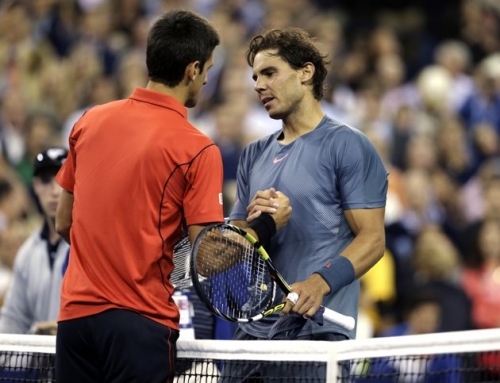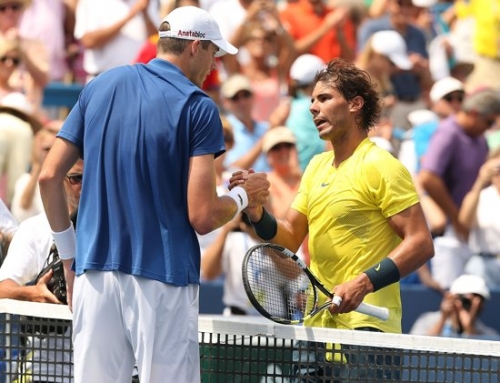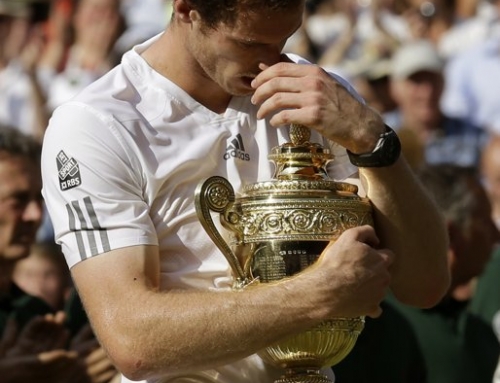It can be a little deceptive to use a player’s form heading into the US Open as a prediction of how the US Open will turn out.
Let’s take a look at last year’s US Open and how various players did leading up to that point. Recall Roger Federer reached the finals of Toronto and defended his title in Cincinnati. He reached the semis of the US Open which, well, isn’t that bad. He did have match points against Djokovic, so he was very close to getting to the finals.
However, everyone felt Roger was the favorite to win the US Open. Contrast this with Rafael Nadal.
Nadal reached the semis of Toronto and lost to Andy Murray, and then lost in the quarters of Cincy to Marcos Baghdatis. People felt that he hadn’t reached peak form and that he was inconsistent. The one positive was his serve which he was hitting harder than he ever had, but he had lost some consistency off the ground. Of course, we know Rafa won the US Open.
Andy Murray won Toronto, but lost early to Mardy Fish in the quarterfinals. Murray actually struggled a bit to get past Ernests Gulbis in the previous round, and looked a bit weary. Murray lost in the US Open early to frequent hitting partner, Stan Wawrinka, in the third round. Murray blamed his poor play on peaking too early at Toronto. Murray was considered a favorite to win his first US Open, though clearly not as much as Federer or Nadal.
Novak Djokovic had lost in the semis to Roger Federer at Toronto, then lost to Andy Roddick in the quarterfinals at Cincy. Back then, the heat bothered Djokovic. He was still considered an up-and-down player. In 2010, he lost to Tsonga in the Australian Open and to Jurgen Melzer at the French, matches he should have won. He reached the semis of Wimbledon which was a much better performance than he had in two years. He was still tinkering with his serve. However, historically, Djokovic had been most consistent at the US Open, reaching the semis the last few years and the finals back in 2007. Djokovic tended to play well on clay, then play well at the US Open and afterwards.
Despite this, Djokovic did not do as well as Federer and Murray heading into the US Open, so there was some thought that he might lose early, in particular, to Mardy Fish, who was having his best summer. However, Djokovic had a very easy win over Fish and reached the finals of the US Open for his second time (since 2007).
Mardy Fish had something of an unfortunate draw. Although he had a good summer, his ranking only got up to about 20, so he was vulnerable to playing a high seed as soon as the third round. He did get to the fourth round. This year, with Fish in the top ten, he won’t meet a player of Djokovic’s caliber until the quarterfinals.
Let’s look at two players who did very well at last year’s Open. Stan Wawrinka and Mikhail Youzhny. Wawrinka really benefited from Murray’s relatively nice draw. Once he beat Murray, he played Sam Querrey. Querrey was having a pretty good summer as well (he’s injured this year), and beat him in 5 sets. He lost to Youzhny in the quarterfinals in 5 sets.
How did both players do leading up to the US Open? Wawrinka lost to Nadal at Toronto in the second round, which was mostly unfortunate. But he lost to Julien Benneteau in the second round at Cincy. So, he only won two matches in the two big events heading into the US Open. Youzhny lost to Dolgopolov in the second round at Toronto and to Richard Gasquet in the first round at Cincy, so Youzhny did even worse. But Youzhny had had a good 2010, especially on clay last year, so despite not playing well, a friendly draw had him matched against players that he had a solid chance. He didn’t have to play a top seed until the semifinals of the US Open.
Andy Roddick had reached the semis of Cincy, losing a close match to Mardy Fish. Again, people thought he might do well at the US Open, but he lost to Janko Tipsarevic in the second round for yet another disappointing US Open.
So with that, let’s look at the form of the top players, realizing how they’ve played the last few weeks may not reflect how they’ll play at the US Open.
Novak Djokovic
Novak Djokovic had only lost one match this year, that to Roger Federer at the French Open. However, with his retirement against Andy Murray, two questions have come up. Is Djokovic still suffering from heat/humidity? Is his shoulder going to give him problems? At times, Pete Sampras had shoulder issues too, and used cortisone injections to help him (which may have hurt in the long run). The shoulder injury seems serious, but here are some things that might work in Djokovic’s favor. The US Open is two weeks long with a day of rest between rounds except at the very end. Perhaps it’s not nearly as serious as it looks.
Djokovic had to deal with his shoulder before, it seems. Recall Djokovic was changing his serve motion. One reason he did this was pain in his shoulder.
But this is the real question mark. This may become the most significant injury heading into the US Open since 2009 when Rafael Nadal had an abdominal pull. Nadal managed to fight his way through a win over Monfils, but he was pummeled by del Potro.
Djokovic looked a lot more solid in the clay events leading up to the French in terms of quality of play than he did in the past two tournaments where he’s played solid, but not at that stellar level. Of course, given his quality of play, a solid level is still more than a match than most, but Djokovic didn’t have to play any of the other top 3 players in Montreal, so maybe his win streak might have been over sooner, except the others are even worse off.
I’d say Djokovic is still the prohibitive favorite to win the US Open, but it really depends on his shoulder. In interviews following the match, Djokovic seemed confident that his shoulder would be ready to go by the US Open. He had yet to get an MRI because of his busy playing schedule.
Rafael Nadal
Nadal is not heading into the US Open in the best of form. He lost early to Ivan Dodig at Montreal in crisis of confidence. Give credit to Dodig for keeping in this match. He kept hitting big shots, and he served huge. But Nadal had breaks three different times to close the match, and couldn’t do it.
Then, Nadal ran into something he couldn’t predict. A overly hot ceramic plate. Nadal burned fingers on his right hand, which is perhaps one of the few times Nadal is happy that he is not a natural left-hander. Nadal seemed to lack a bit of confidence hitting big off his backhand. Nadal was pushed by Verdasco in his second match at Cincy in a match of two players that let nerves bother them. Verdasco probably should have won this match except he kept going for big shots at inopportune moments.
Nadal lost to a very aggressive Mardy Fish who kept his mental game together, and pressured Nadal off the ground. I think this loss was reasonable given Nadal’s lengthy match against Verdasco.
The two big issues for Nadal is getting consistency for the US Open, dealing with his confidence issues, and the burn on his right hand. Presumably, with another week before the US Open, Nadal’s fingers ought to be fine. The question is how it will affect his training. I tend to think Nadal will feel pretty good heading into the US Open, but he’s probably lacking the same confidence as he had last year. But given Nadal’s style of play, a player has to take the game to Nadal to win.
I’m a little less worried about Nadal’s form heading into the US Open as I am about Djokovic.
Roger Federer
Last year, Roger Federer was the hottest player heading into the US Open. His good play went beyond the US Open. He reached he finals of Shanghai. He won Stockholm (to tie Sampras’s number of titles won), then won Basel. He reached the semis of the Paris Indoors, losing to Monfils after having match points. He won the year-end championship. In the process, he beat Novak Djokovic three times.
Federer got to the semifinals of the Australian Open, but couldn’t figure out how to beat Novak Djokovic. Djokovic had taken a big leap in his game, and it caught Federer (and Murray) by surprise.
Federer played well in the spring, but couldn’t figure out how to get past Djokovic and Nadal. He then lost to Melzer and Gasquet. Federer lost to Tsonga at Wimbledon, and lost to him again at Montreal. Federer also lost to Berdych at Cincy.
Federer doesn’t appear to have any injuries heading into the US Open. He claimed he was feeling a bit slow at Montreal and that his footspeed was better at Cincinnati. Federer is now losing to players that were the kind that used to give Murray trouble, hard hitters with big serves. Both Tsonga and Berdych fit this mold. Technically, so does del Potro, but Delpo’s game is still not quite to where it was in 2009, although he did play pretty aggressive. It was probably Federer’s best match against quality opponent.
Of the top four, Federer might be heading a bit under the radar, which is impressive given how good he is. Still, he’s not shown that he’s playing as good as he was last year at this time. At that time, I think Federer felt pressure to have to play well the rest of the year in the hopes that he could get back to number 1. He made a good push, in particular, he played very well at the ATP World Tour Final, where he earned 1500 points.
What he didn’t expect was Djokovic to play as well as he did. I think Federer’s goal is to win the US Open, and he sees that Nadal might not be 100% and Djokovic might not be 100%, and he probably feels he can beat Andy Murray.
The big question for Roger Federer is whether he can avoid playing impatient tennis which caused his losses to Tsonga and Berdych. Federer knows that Djokovic and Nadal are too far ahead to get better than a 3 seed. At this point, he probably hopes to be on Djokovic’s side of the draw (which happens uncannily often) at the US Open and hopes he’s not playing as well as he could be.
Andy Murray
Andy Murray had a poor Montreal. He lost handily to Kevin Anderson. Murray generally does well against big players. He’s got good records against Querrey, Isner, and the like. While Murray didn’t like losing that early, he seemed to think it wasn’t too big a deal. In the past, he had played well in Canada, but poorly at the US Open. Commentators would point out that he reached the finals in 2008, but he only got to the fourth round in 2009 and the third round last year. For a guy who places a premium at the US Open, he has often played better at Wimbledon.
Murray won Cincy, but I would say he didn’t play nearly as well as he did at Toronto last year, where his offensive style was on full display and knocked out three good opponents. In particular, if Djokovic had been in good form, I think this might have gone the other way. The one positive was Murray’s return game where he had success breaking players, in particular, Simon, Fish, and yes, even Djokovic.
There was one rally, in particular, in the first set that went over 40 shots. Murray eventually won this in an interesting manner. Murray had begun moving to his right when Djokovic hit an inside out forehand back to Murray’s backhand. It wasn’t anything special in terms of angle, but it caught Murray by surprise. Murray sliced the ball short and up the middle. Djokovic hit the forehand back inside out and approached the net. Murray aimed a passing shot down the line. Djokovic popped up the volley. Murray passed him.
The sequence wasn’t so unusual. The men pass so well that approaches ofteusn don’t make sense, and yet, players are taught from early on to attack short balls. What was unusual was the length of the rally which ran 42 shots. Murray broke with that rally and went up a break in the first set, and then secured that first set.
There were a few positives as well. Murray was back to hitting balls down the line on forehand and backhand. Key to Djokovic’s success this year (and in the past) is his confidence hitting down the line. He’s always loved to do this, so he has great confidence. Murray, on the other hand, prefers to hit crosscourt almost always. But without the threat of down the line, you give your opponent less court to cover. In this match, Murray went down the line to change the groundstroke exchanges.
Murray has an unusual philisophy on serve that sometimes gets him in trouble. He figures there are few players that attack the return of serve. So despite missing a lot of first serves, he wants his first serve to be nearly unreturnable so he gets lots of free points off it, and then he figures his chances are better than even to win on second serve. At times, he spins the ball directly in the middle of the service box, presumably because it changes the angle of the ball, and doesn’t kick nearly as high.
Few people seem to say “that’s an attackable ball”, and so there’s no consequence for hitting the second serve that short. It is certainly in stark contrast to Djokovic or Nadal who prefer to hit with a high first serve percentage. For Murray, 60% is considered pretty good.
Murray says he needs more work on his game before the US Open, and that seems about right. I feel like he’s not played that many points where he’s dominated off the ground. I remember, when I saw Murray playing at Hopman Cup in 2010, and remarked just how well he was moving. He was blazingly quick. Indeed, against Cilic, you saw some of his tremendous speed. I don’t feel Murray has reached that peak, though speed is one of those things that seem to come and go as the body’s desire and injury dictate. Federer, for example, complained about his movement in Montreal, as did, say, Murray.
The big question, it seems, is whether Murray’s new preparation will pay off. Murray played only one of the other big three, namely, Djokovic. Djokovic was not at his best playing Murray.
Overall, as far as physical shape goes, I think Murray is in about the same spot as Federer. They both played enough matches, got decent enough wins, and don’t appear to be hurt heading into the US Open. It seems ideal.
Best of the Rest
The one other player that played very well this summer was Mardy Fish. Fish won Atlanta, reached the finals of Los Angeles and Montreal, and reached the semis of Cincy beating Nadal for the first time. Fish dropped out of Winston-Salem (he had signed up for all the US Open series events, but dropped out of DC to rest his heel) so he could prep for the US Open. He has to believe this is his best chance to go deep, though he would hope to avoid certain dangerous players (Berdych, Tsonga, to name two). Fortunately, these players are ranked in the top ten (or so), and with his high seeding, he’s unlikely to meet them.
This summer hasn’t been so great for Isner, Querrey (whose out with an injury), and Roddick. It’s actually been OK for James Blake, who has won a few matches.
As usual, the US Open is likely to have some surprises, players that didn’t play so great in the tuneups. Perhaps Ferrer. Perhpas Simon. Perhaps Gulbis or del Potro or Gasquet.
I mean, ask yourself, did you pick Youzhny to reach the semis last year?




![[US Open Men’s Final] Can Djokovic beat Nadal in the finals?](https://www.essentialtennis.com/wp-content/uploads/2013/09/20130909djokovic-500x383.jpg)


![[French Open] The tactics of the Djokovic-Nadal semifinals](https://www.essentialtennis.com/wp-content/uploads/2013/06/20130607nole-500x383.jpg)